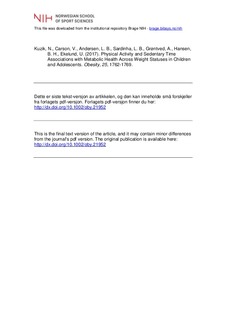| dc.contributor.author | Kuzik, Nicholas | |
| dc.contributor.author | Carson, Valerie | |
| dc.contributor.author | Andersen, Lars Bo | |
| dc.contributor.author | Sardinha, Luís B. | |
| dc.contributor.author | Grøntved, Anders | |
| dc.contributor.author | Hansen, Bjørge Herman | |
| dc.contributor.author | Ekelund, Ulf | |
| dc.date.accessioned | 2018-09-20T07:50:38Z | |
| dc.date.available | 2018-09-20T07:50:38Z | |
| dc.date.created | 2017-12-22T10:36:35Z | |
| dc.date.issued | 2017 | |
| dc.identifier.citation | Obesity. 2017, 25, 1762-1769. | nb_NO |
| dc.identifier.issn | 1930-7381 | |
| dc.identifier.uri | http://hdl.handle.net/11250/2563548 | |
| dc.description | I Brage finner du siste tekst-versjon av artikkelen, og den kan inneholde ubetydelige forskjeller fra forlagets pdf-versjon. Forlagets pdf-versjon finner du på tandfonline.com onlinelibrary.wiley.com / In Brage you'll find the final text version of the article, and it may contain insignificant differences from the journal's pdf version. The definitive version is available at onlinelibrary.wiley.com | nb_NO |
| dc.description.abstract | Objective: The aim of this study was to examine the prevalence of metabolic health across weight statuses and the associations of physical activity and sedentary time within and across metabolic health-weight status groups. Methods: Six studies (n = 4,581) from the International Children's Accelerometry Database were used. Sedentary time, light physical activity, and moderate to vigorous physical activity (MVPA) were accelerometer derived. Individuals were classified with normal weight (NW), overweight, or obesity. Strict and lenient composite definitions of metabolic health were created. Binomial and multinomial logistic regressions controlling for age, sex, study, and accelerometer wear time were conducted. Results: The metabolically unhealthy (MU) prevalence was 26.4% and 45.6% based on two definitions. Across definitions, more sedentary time was associated with higher odds of MU classification compared with metabolically healthy (MH) classification for the NW group. More MVPA was associated with lower odds of MU classification than MH classification for NW and overweight groups. For multinomial logistic regressions, more MVPA was associated with lower odds of MH-obesity classification, as well as MU-NW, -overweight, and -obesity classifications, compared with the MH-NW group. Furthermore, more sedentary time was associated with higher odds of MU-NW classification compared with the MH-NW group. Conclusions: More MVPA was beneficial for metabolic health and weight status, whereas lower sedentary time was beneficial for metabolic health alone, although associations were weak. | nb_NO |
| dc.language.iso | eng | nb_NO |
| dc.subject | adolescent | |
| dc.subject | body weight/physiology | |
| dc.subject | child | |
| dc.subject | exercise/physiology | |
| dc.subject | female | |
| dc.subject | health status | |
| dc.subject | humans | |
| dc.subject | male | |
| dc.subject | obesity/epidemiology | |
| dc.subject | sedentary lifestyle | |
| dc.title | Physical Activity and Sedentary Time Associations with Metabolic Health Across Weight Statuses in Children and Adolescents | nb_NO |
| dc.title.alternative | Physical Activity and Sedentary Time Associations with Metabolic Health Across Weight Statuses in Children and Adolescents | nb_NO |
| dc.type | Journal article | nb_NO |
| dc.type | Peer reviewed | nb_NO |
| dc.description.version | acceptedVersion | nb_NO |
| dc.source.pagenumber | 1762-1769 | nb_NO |
| dc.source.volume | 25 | nb_NO |
| dc.source.journal | Obesity | nb_NO |
| dc.source.issue | 10 | nb_NO |
| dc.identifier.doi | 10.1002/oby.21952 | |
| dc.identifier.cristin | 1531379 | |
| dc.description.localcode | Seksjon for idrettsmedisinske fag / Department of Sport Medicine | nb_NO |
| cristin.unitcode | 150,34,0,0 | |
| cristin.unitname | Seksjon for idrettsmedisinske fag | |
| cristin.ispublished | true | |
| cristin.fulltext | postprint | |
| cristin.qualitycode | 1 | |
